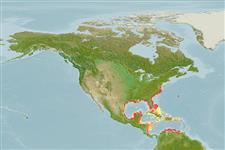Common names from other countries
Classification / Names / Names
Nomi Comuni | Sinonimi | Catalog of Fishes (gen., sp.) | ITIS | CoL | WoRMS
Environment: milieu / climate zone / depth range / distribution range
Ecologia
; salmastro; distribuzione batimetrica 0 - 11 m (Ref. 83435). Subtropical; 42°N - 10°N, 98°W - 63°W
Western Atlantic: North America, from New York to Texas and Mexico, throughout the Gulf of Mexico. The Sea of Marmara and the Mediterranean: Introduced in Egypt and Turkey. Tropical to subtropical.
Length at first maturity / Size / Peso / Age
Maturity: Lm ? range ? - ? cm Max length : 1.9 cm DL maschio/sesso non determinato; (Ref. 83435); Età massima riportata: 1.00 anni (Ref. 8702)
Found in the intertidal zone on coarse-grained (Ref. 104171) sandy beaches (Refs. 104348, 104171). Some migrate up and down the beach with the tides (Ref. 104348). Actively migrates by jumping out of the sand and riding specific waves (Ref. 104171). Filter-feeder (Ref. 104245). Feeds on phytoplankton, algae, detritus, bacteria and other small suspended particles via its short siphons (Ref. 104246).
Life cycle and mating behavior
Maturità | Riproduzione | Deposizione | Uova | Fecundity | Larve
Semelparous species (Ref. 104352). Members of the class Bivalvia are mostly gonochoric, some are protandric hermaphrodites. Life cycle: Embryos develop into free-swimming trocophore larvae, succeeded by the bivalve veliger, resembling a miniature clam (Ref. 833).
Bisby, F.A., M.A. Ruggiero, K.L. Wilson, M. Cachuela-Palacio, S.W. Kimani, Y.R. Roskov, A. Soulier-Perkins and J. van Hertum. 2005. (Ref. 19)
IUCN Red List Status (Ref. 130435)
CITES status (Ref. 108899)
Not Evaluated
Not Evaluated
Human uses
Pesca: pesca di sussistenza
| FishSource |
Strumenti
Fonti Internet
Estimates based on models
Preferred temperature
(Ref.
115969): 23.4 - 28, mean 26.8 (based on 348 cells).
